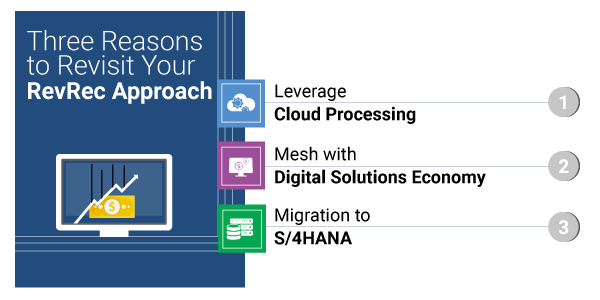Did you hope that the whole Revenue Recognition change process was really behind you? Most companies have already spent significant time, effort and resources to comply with ASC 606 / IFRS 15 accounting requirements in one way or another. It's natural to yearn for closure and move on to other issues.
But there are some very compelling reasons why you should revisit your RevRec processes, with an eye toward the future and within the context of the Comply, Optimize, Transform™ paradigm.
Let's take a look at three major areas of opportunity for leveraging RevRec as a key driver for improving your overall business processes, productivity and agility going forward.

1. Leveraging Automated Revenue Management in the Cloud:
When most companies first started their ASC 606 / IFRS 15 compliance journeys, the focus was primarily on meeting the requirements and the deadlines so, depending on their specific situation, companies made choices and tradeoffs among the available range of standalone software, offline spreadsheets, and integrated approaches like SAP's Revenue Accounting and Reporting (RAR). Now, as new alternatives such as SAP Automated Revenue Management (ARM) offer fully integrated cloud-based capabilities, a whole new set of opportunities have opened up within the path forward.
One major benefit of moving to the cloud is built-in scalability and flexibility, both in terms of meeting higher transaction volumes and addressing more complex revenue accounting scenarios.
Another benefit is the ability to quickly upgrade from sub-optimal compliance methods (standalone or offline) by moving to a comprehensive cloud environment that includes multi-faceted capabilities to address a wide range of current and future RevRec scenarios.
As part of the SAP Intelligent Enterprise, ARM in the cloud helps drive innovation, scalability and transparency by integrating with third-party applications, optimizing closing, providing disclosures and reporting, and integrating Embedded Analytics. At Bramasol, we also have found related initiatives, such as SAP RISE, offer excellent opportunities for accelerating the overall cloud migration process.
2. Meshing Revenue Management with the Digital Solutions Economy:
As discussed in our series of blog posts on the Digital Solutions Economy, revenue management is a key element that must adapt to track with dynamically changing DSE product and service offerings. All DSE business models still must comply with revenue accounting standards (ASC 606 & IFRS 15) so it is critical that your revenue management processes mesh with and adapt to your other DSE processes including Order Management, Billing, Invoicing, Fulfillment and more.
For some DSE situations, such as where equipment leasing is bundled with related consumables or services, lessor companies also need to mesh their ASC 842 / IFRS 16 accounting processes with their revenue management processes.
This is another area where the SAP applications and analytics ecosystem brings added value because DSE-related application suites such as Billing & Revenue Innovation Management (BRIM), Contract and Lease Management (CLM), and SAP Analytics Cloud (SAC), are inherently able to cross communicate with ARM and other ERP and finance functions using S/4HANA's unified database model.
3. Moving Revenue Management to S/4HANA:
That brings us to the third major opportunity area, which is migration from existing ECC or other legacy environments to revenue management within the SAP S/4HANA platform. After some postponements due to COVID 19 and other factors, the movement from ECC to S/4HANA is now heating up rapidly.
As we simultaneously work with clients on their RevRec compliance and S/4HANA migration journeys to the Intelligent Enterprise, it's important for them to understand upfront that the SD RevRec processes they may be using in ECC will not be natively available in S/4HANA. (Although many SD RevRec scenarios could be supported via ARM.)
More importantly, they should be aware of the major benefits that will be achieved by migrating to Automated Revenue Management as an integrated S/4HANA application.
In S/4HANA, the revenue process is fully integrated into the Universal Journal and so revenue recognition data is stored in the same location as cost and revenue data. This effectively eliminates the need for reconciliation of separate data stores and provides a seamless ability to drill down into G/L accounts for full transparency. As a result, both event-based revenue recognition (EBRR) and real-time reporting are enhanced.
Also, with S/4HANA, Revenue Accounting, Contract Management and Inbound Processing have all been optimized for better performance and improved functionality. The enhanced ARM capabilities provide many additional features, such as Optimized Contract Management (OCM), day-based contract modifications, FIORI user interfaces, and seamless S/4HANA based disclosure reporting.
Summary:
All three of the above areas represent major opportunities with potential benefits for any company that falls under ASC 606 / IFRS 15 compliance requirements (virtually everyone) and that wants to map out a future driven by growth and profitability (everyone). So NOW is the time to take a hard look at your revenue management, recognition and reporting processes, with an open mind to the rich possibilities for making a giant leap forward in your Comply, Optimize, Transform journey.
More Related Resources:
- Automated Revenue Management – Compliance to Optimization and Transformation
- Webcast Video: Overview of the Digital Solutions Economy
- Revenue Accounting for Next-Gen Scenarios
- Hyperscaling is Key to Successful Digital Transformation
- R2R Series Blog #9 Automated Revenue Management | SAP Blogs

